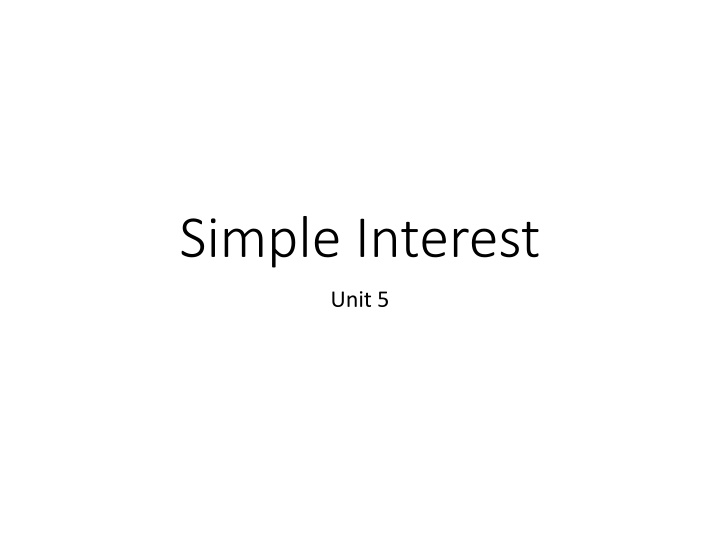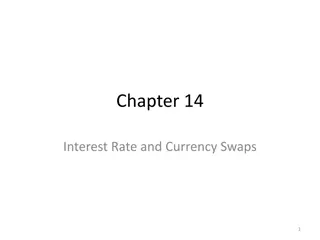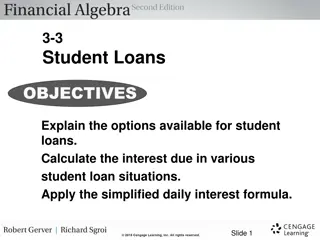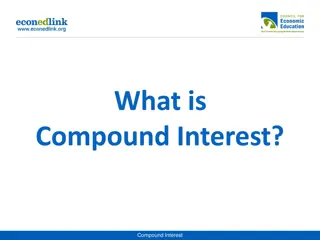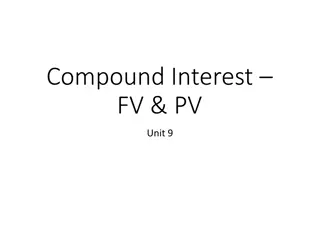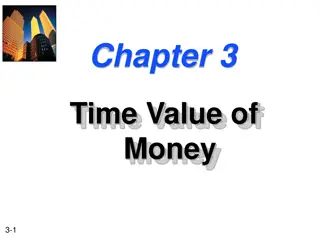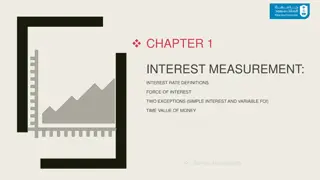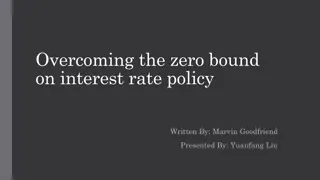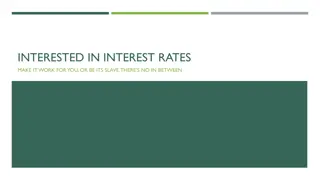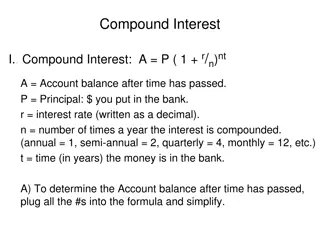Simple Interest Essentials
Gain a comprehensive understanding of simple interest calculations, including computing interest, principal, and maturity value. Explore the relevance of simple interest in business transactions and learn how to match time periods with interest rates for accurate calculations. Enhance your skills in days calculation between two dates and practice questions for practical application.
Download Presentation

Please find below an Image/Link to download the presentation.
The content on the website is provided AS IS for your information and personal use only. It may not be sold, licensed, or shared on other websites without obtaining consent from the author.If you encounter any issues during the download, it is possible that the publisher has removed the file from their server.
You are allowed to download the files provided on this website for personal or commercial use, subject to the condition that they are used lawfully. All files are the property of their respective owners.
The content on the website is provided AS IS for your information and personal use only. It may not be sold, licensed, or shared on other websites without obtaining consent from the author.
E N D
Presentation Transcript
Simple Interest Unit 5
Objectives 1. Compute the amount of simple interest using the formula I = Prt 2. Compute the principal, interest rate, or time using variations of the formula I = Prt 3. Compute the maturity value (future value) using the formula S = P(1 + rt) 4. Compute the principal (present value) using the formula S P = 1 + rt 5. Compute equivalent or dated values for specified focal dates
Simple Interest What is it? Transactions in business often involve the daily borrowing or lending of money To compensate the lenders interest is paid Think of it as rent charged for the use of money Interest paid is based on three factors: the amount of money borrowed, the rate of interest at and the time period for which it is borrowed
Transactions Involving Simple Interest Term deposits and other short-term investments Canada savings bonds Credit card transactions Purchases on credit from vendors Short-term loans
Calculation of Simple Interest Formula ? = ??? I is the amount of interest earned P is the principal sum of money earning the interest, r is the simple annual (yearly or nominal) rate of interest expressed as a percent, which can be converted into a decimal t is the interest period in years (usually) Note the difference between r (RATE of interest) and I (AMOUNT of interest).
Computing Days Between Two Dates Will demonstrate in class most convenient to use your calculator We will use both the BA II Plus and the TI 83/84
Matching r and t When using the simple interest formula, it is imperative that the time t correspond to the interest rate r Time expressed in months or days often needs to be converted into years Months Years (divide by 12) Days Years (divide by 365) Alternatively if the interest rate is per month the time needs to be in months The same is true for days
Practice Questions Q8. RMB Equipment charged interest at 2% p.a. on overdue accounts. An invoice for $21,000 plus interest, was paid 35 days past the due date. How much interest was paid?
Practice Question Q16. Mac s credit card statement included $360 in cash advances and $3.20 in interest charges. The interest rate on the statement was 13.5%. For how many days was Mac charged interest?
Computing Future Value (Maturity Value) When you borrow money, you are obligated to repay, at some point in the future both the sum borrowed (the principal) any interest due ?????? ????? (???????? ?????)= ????????? + ???????? ? = ? + ?
Computing Future Value (Maturity Value) Since I = Prt S = P + I Then S = P + Prt We can simplify this ? = ? 1 + ??
Practice Questions Q6. Prairie Grains Cooperative wants to invest $45,000 in a short term deposit. The bank offers 1.3% interest for a one year term and 1.1% for a six month term. A. How much Prairie Grains receive if the $45,000 is invested for one year? B. How much would Prairie Grains receive at the end of one year if the $45,000 is invested for six months and then the principal and interest earned is reinvested for another six months. C. What would the one year rate have to be to yield the same amount of interest as the investment described in part (b)?
Finding the Principal (Present Value) The present value of an amount at any given time is the principal needed to grow to a desired amount at a given rate of interest over a given period of time 1 ( = S P I like this one better as it is easier to use when calculating equivalent payments + 1 ) rt Both formulas give the same answer. ? ? = 1 + ??
Practice Questions Q8. On March 15, 2020, Ben bought a government guaranteed short term investment maturing on September 12, 2020. How much did Ben pay for the investment if he will receive $10,000 on September 12, 2020, and interest is 2.06%?
Equivalent Payments - Choosing Between Finding S and P Select a focal date or comparison date. If the due date fallsbefore the focal date, find the future value by using S = P(1+rt). If the due date falls after the focal date, find the present value 1 ( + = S P 1 ) rt ? OR ? = ? + ??
Equations of Values at Focal Date To solve equations of value or replacement payments, make the sum of the dated values (equivalent payments) of the replacement payments equal to the sum of the dated values of the original payments ??? ?? ????? ?????? ?? ??????????? ????????=??? ?? ????? ?????? ?? ???????? ????????
Loan Repayments Loans by financial institutions to individuals are usually repaid by blended payments i.e. payments that include principal and interest To repay the loan, the sum of the present values of the periodic payments must equal the original principal This is called the Valuation Principle
Equivalent Payments - Example Jane is owed payments of $500 four months ago, $800 today, and $400 in three months from Kristen. Both have agreed instead to make a single payment one month from today. If money is worth 6.5% and the agreed focal date is one month from today, what is the size of the replacement payment? Important first step draw a timeline!!
Equivalent Payment Practice Q12. Judy received a payment of $2950 and used it to pay back two equal outstanding loans from 45 days ago and 190 days ago. If interest is 12.5% on the loans, and the agreed focal date is today, what was the size of the equal amounts borrowed? Q16. On March 1, Bear Mountain Tours borrowed $1500. Three equal payments are required, on April 30, June 20, and August 10, as well as a final payment of $400 on September 30 of the same year. If the focal date is September 30, what is the amount of the equal payments at 6.75%?
